Roy Symonds reports the following sightings on 31st March from Stansted Forest (SU7411) where the temperature was 12°C. Brimstone 3M, Comma 3, Peacock 2. (Richard Symonds)
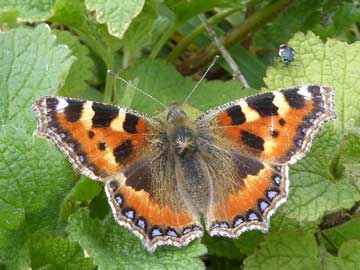
Today I walked a circuit between Cissbury and Chanctonbury Rings and saw several Small Tortoiseshell, a Peacock and a Red Kite. (Patrick Moore)
It finally feels like Spring! Lots of butterflies today with 5 species recorded. First were a pair of Small Tortoiseshell and a Peacock in my Hailsham Garden. Then an early afternoon walk around Rowland Wood yielded another Small Tortoiseshell, 3 Peacock, a Comma and at least 12 male Brimstone. Finally I saw a Small White near Hailsham town centre mid-afternoon. After a very slow start to my butterfly year it has ended up as being the most productive March species-wise that I have had (with 6 in total). (Chris Hooker)
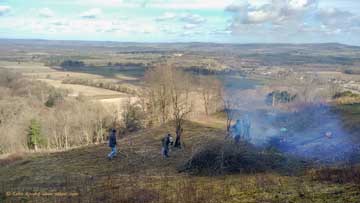
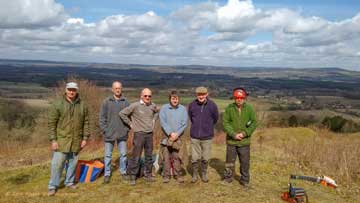
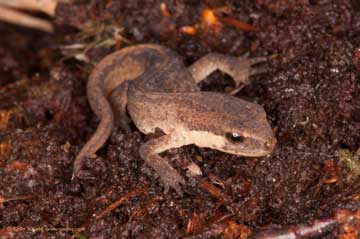
Today Paul Day and Nigel Symington joined me at the final Heyshott work party of the season on a fine day. Afterwards I saw a Marsh Tit at Heyshott Common, followed by hibernating newts at a woodland site. This afternoon Sue and I visited Angmering Woods. While I was watching a goldcrest hopping around a leafless tree by the path, Sue spotted two male Brimstones fluttering through the woods 50 metres away. (Colin Knight www.seapic.com )
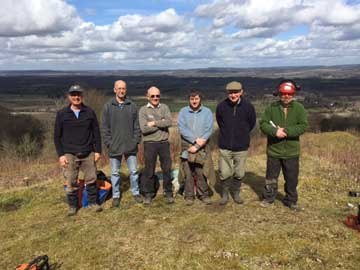
My picture shows BC volunteers Colin and Paul alongside Murray Downland's Andy, Greg, John and Mike at the end of the last work party of the season on Heyshott escarpment. This is a rare image of Colin who has been a steadfast attendee of these days but has usually been behind the camera. (Nigel Symington)
At the same time this morning, a Small White and a Small Tortoiseshell flew across my Seaford garden. (Stuart Ridley)
Saw my first Small White of the year today in my Lindfield garden. (Bob Foreman)
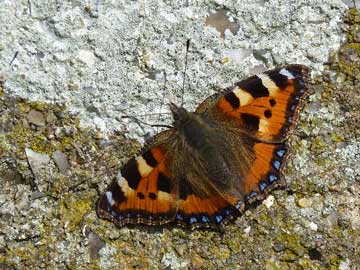
This was my third visit to Ferring Rife this March, made to assess the environmental damage caused by an environmentally inappropriate cut of the banks (c.95% coverage) in late July 2015. This site supports the largest population of Small Tortoiseshell in West Sussex, and has probably played an important role in the species' local recovery since 2012, and particularly 2013. In late July the nettles which blanket the bank and overbank areas are covered in great clusters of the butterfly's eggs (often 100 in a single batch), and the communal caterpillar webs which are constructed towards the top of the plant. This leaves the species highly vulnerable to a wholesale nettle cut at this time of year. Based on a comparison of the maximum daily count achieved this spring (the 18 seen today being the best yet) with the averaged, maximum counts for the period 2013 - 2015, early indications suggest a decline of 84%. This demonstrates quite clearly the folly of abandoning one of the most basic principles of habitat management, that you don't subject it all to the same treatment at the same time. Needless to say, the negative impact on the Small Tortoiseshell is just one example of the much wider damage to the area's fauna and flora which will be caused by such a management regime. Let's hope that this environmentally important local nature reserve and Site of Nature Conservation Interest (SNCI) is cut in a more sensitive manner this year. Discussions with the agency responsible for the management of the reserve have met with limited success so far. (Neil Hulme)
A single Speckled Wood on the wing in our Worthing garden this morning was the second earliest date that we've recorded. (John & Shena Maskell)
News for Friday 25 March:
I was thrilled to see a Humming-bird Hawk-moth at Birling Gap on Friday, nectaring on daffodils in the courtyard by the café. (Matt Farmer)
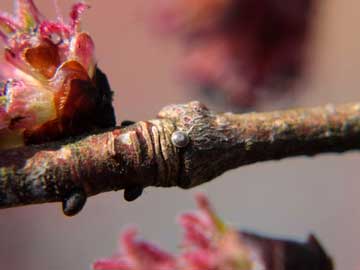
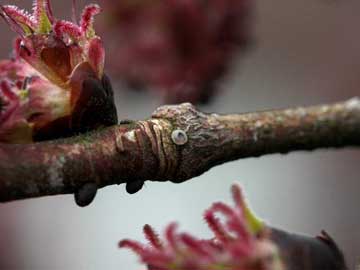
I've continued to closely follow the developments of two White-letter Hairstreak eggs, having found both within Hollingbury. To avoid confusion between the developments of these two eggs the first egg I found will only be mentioned. I was amazed to find that the first egg had hatched. Hatching occurred between my visits on 25 March at 10:30 a.m. and 26 March at 12:10 p.m. Based on the weather from these two days it would make sense that this egg hatched during stable warm weather experienced on the 25 March, sometime after my 10:30 a.m. visit. The 26 March in comparison was cool and overcast. It certainly didn't pick a great time to hatch! I've seen rain, wind and now hail since finding that it's hatched. If I manage to locate the caterpillar somewhere withing the flowers, it will show what extremes these little things can withstand. (Jamie Burston)
Friday 25 March
15 Brimstones (all male) seen during a two-hour walk this morning around the eastern heath at RSPB Broadwater Warren. (Alan Loweth)
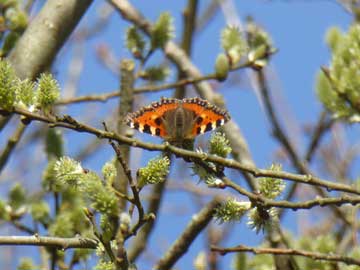
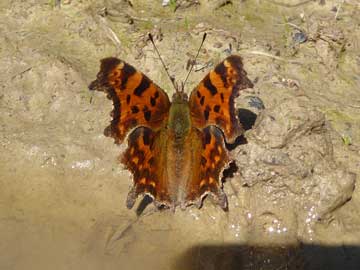
Today I set out on a walk to see butterflies. St Leonards Forest provided Small Tortoiseshell, Brimstone, Peacock and Comma. It really was a very Good Friday! (Patrick Moore)
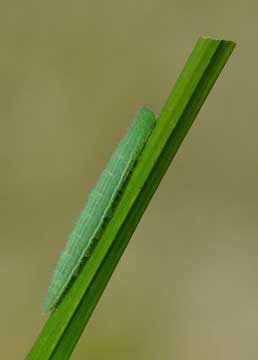
The Wall Brown larvae are now reaching fully grown and getting harder to find as they move away in preparation for pupation. Today I found 5, of which 4 were just about fully grown. Also at High and Over several Small Tortoiseshell, 2 Brimstone and 1 Peacock. (Bob Eade)
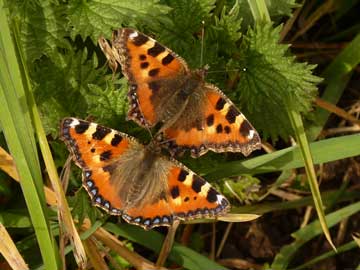
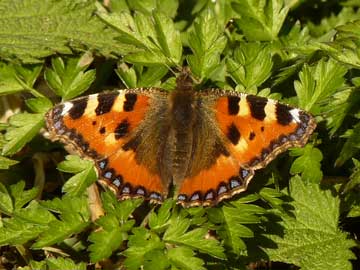
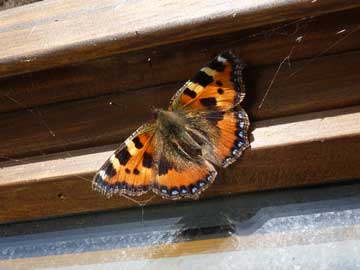
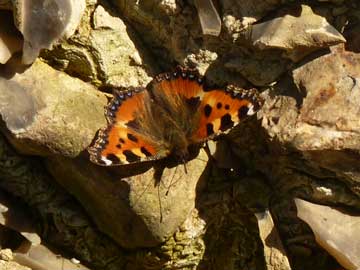
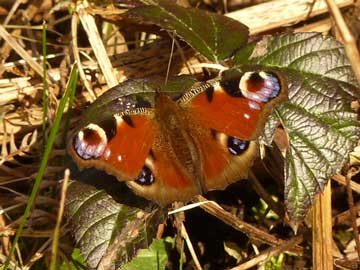
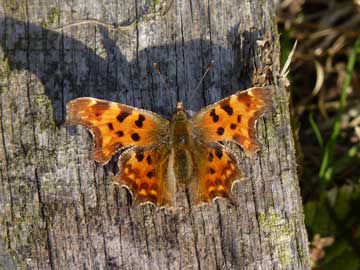
30 to 40 Small Tortoiseshells seen at Halnaker today, emerging from outbuildings and warming up, also many fluttering around a nearby meadow. A later visit to Eartham Woods produced a Peacock and a Comma. (Trevor Rapley)
Made the most of the fabulous weather today with a walk up Mount Caburn to take in what must surely be one of the finest views in England let alone Sussex. Skylarks and Buzzards aplenty but unsurprisingly no butterflies - on the way there and around Glynde we counted 8 male and my 1 female Brimestone and a single Peacock. (bob Foreman and Jo Godbolt)
Recent news:
Roy Symonds reports the following recent sightings:
On 21st March Stansted Forest (SU7411) temperature 12.5°C. Brimstone (2M), Comma (2), Peacock (1).
On 22nd March Stansted Forest (SU7411) temperature 11°C. Brimstone (1M), Comma (1), Peacock (1). (Richard Symonds)
2 Small Whites at West Tarring allotments 12:30 Monday 21st March. (Mark Senior)
Wednesday 23 March
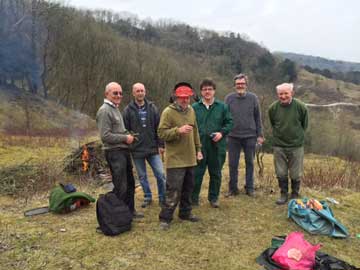
Today I joined Andy, Mike, Nick and John from the Murray downland trust, and Gary and Paul from BC, to clear more scrub on a very steep slope on the Heyshott Escarpment. Good progress made to open up a further area for the Duke. (Nigel Symington)
Tuesday 22 March
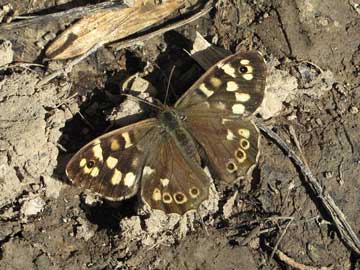
Sunny spells this morning produced my first Speckled Wood of the season in my local woods in Crawley. It beats my earliest sighting for this species by 4 days, although it clearly has wear and has been on the wing for a few days already. Also seen in the locality were a Comma, Small Tortoiseshell and a Red Admiral. The temperature was 11C with a light wind. (Vince Massimo)

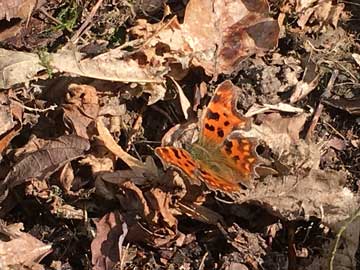
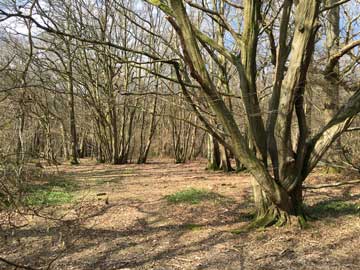
Spatham Lane Woods, Ditchling Common: A walk with the dogs on a perfect Spring day today revealed some very active Commas up close. And a Small Tortoiseshell, Peacock and a Brimstone at distance. The wood was considerably warmer than the open spaces and almost still air. (David Cook)
Gorgeous warm spring morning at Woods Mill. Small Tortoiseshell and three male Brimstones. My first butterflies of the year. Chiff chaff singing and a burst of Cettis warbler. Pity about the weather forecast for the weekend! (Colin Booty)
Sheepcote valley: Saw my first Small Tortoiseshell of the year today which spent about 20 minutes flying round some nettles near the racetrack at the top of the valley - long enough to check size and leg colour carefully! Lower down, a Peacock was basking in the sun. (Nigel Symington)
My first two new species for 2016 seen today. 1x Small White seen flying over gardens in Dover Road at 12.23pm, and 1x Peacock seen flying over Hailsham Road and into garden to feed on Lesser Celendines at 12.55pm, both Polegate, E.Sx. (Peter Farrant)
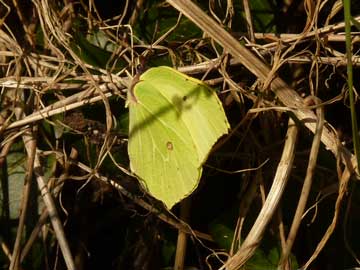
The fine weather today produced two male Brimstones, only one of which stopped briefly for the camera. The location was along the Cuckoo Trail in Hailsham, a superb site for Spring species later on. (Trevor Rapley)
I saw my first male Brimstone of the year flying by the purging buckthorn in my Bevendean Garden today. (Geoff Stevens)
Thursday 17 March
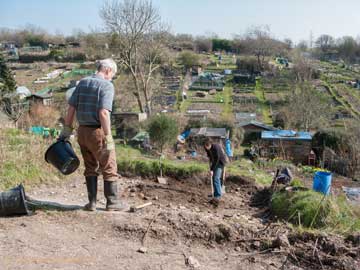
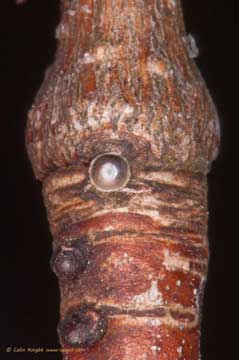
Today I joined Jamie Burston and Peter Atkinson at Jamie's wonderful Brighton allotment project. We removed the remaining topsoil ready for the planting on Saturday. Afterwards Jamie kindly showed me a White-letter Hairstreak egg, a first for me. (Colin Knight www.seapic.com)
Roy Symonds made another visit to Stansted Forest (SU7411) today (17th March) where he saw a single male Brimstone in flight. (Richard Symonds)
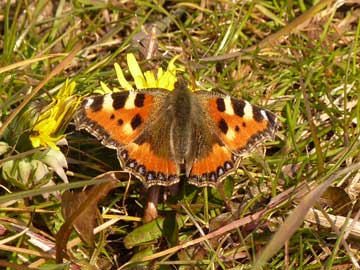
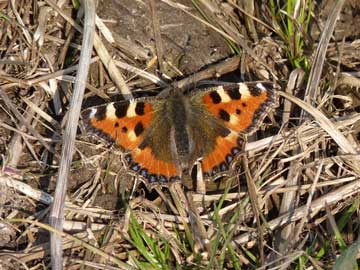
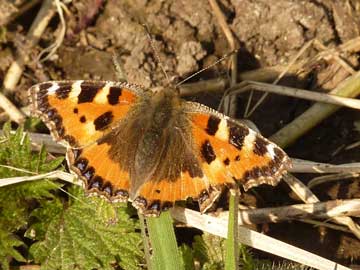
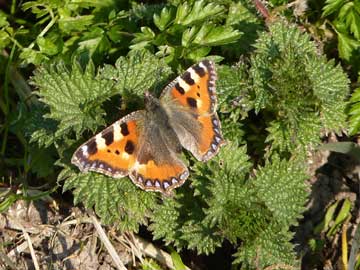
At least eleven Small Tortoiseshells were seen in a meadow at Halnaker, West Sussex, as the ever present bitter east wind subsided, allowing a short spell of warm sunshine. (Trevor Rapley)
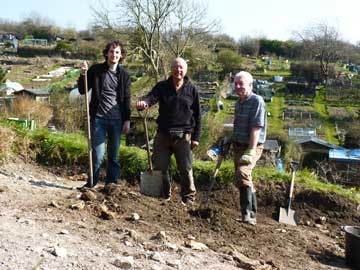
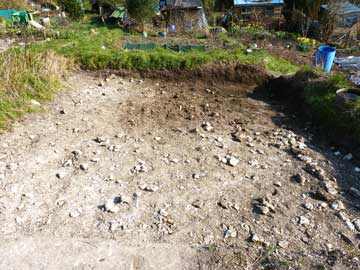
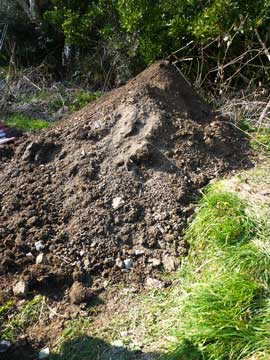
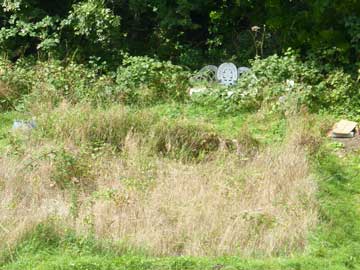
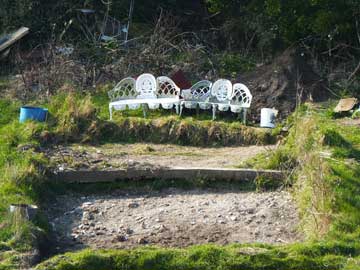
For the last few days I've been working on the BC Butterfly Plot at Roedale Valley Allotments, a few more sessions was needed in preparation for this coming Saturday's work party when the plants go in. I've had the help of my amazing mum Gail and today Peter Atkinson and Colin Knight came. I'm greatly appreciative and thankful for their help. Between us we cleared off the remaining soil from the plot, chalk now exposed. The photo of the mound of soil doesn't do us justice, it was an astonishing amount of soil we removed. The plot is now ready for this Saturday's work party when the caterpillar foodplants and nectar sources will be going in. A session with a mattock will be needed before we begin, in that time information can be provided on the project and the species we hope to see. A comparison is given, overgrown grass and brambles now transformed to chalk for all the warmth loving species. (Jamie Burston)
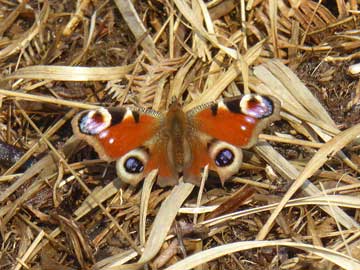
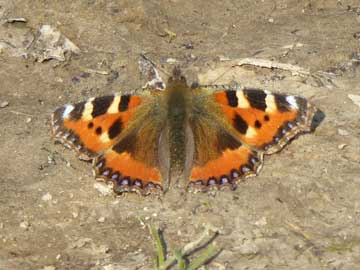
Today in St Leonards Forest several Small Tortoiseshell lifted from the path in front of me before one settled for a photo. I also saw a Peacock on a sunny embankment and Red Admiral. (Patrick Moore)
News for Wednesday 16 March:

Brighton and Hove Allotment Federation AGM: Over 100 people attended this meeting last evening, to which we were invited as holders of our plot in Roedale Valley. The Federation regards their involvement with us as a key component of their initiative to value biodiversity among allotmenteers, which in turn reinforces the aims of the Brighton Hove and Lewes Downs Biosphere. Jamie's development of our allotment was praised several times in speeches from the chair, and there was extensive interest during the breaks in a very attractive table he had arranged. The Federation has designed and produced a leaflet which will be sent to all plot holders, and our web page on butterflies in allotments (sussex-butterflies.org.uk/allotments ) also received plaudits for its clear layout and comprehensive information.
After the AGM there was a talk by gardening celebrity Bob Flowerdew. Among other very practical tips, he said that planting nectar-bearing plants will on their own be insufficient to attract butterflies to the site: he pointed out that it is equally important to add larval food plants. (Nigel Symington)
News for Tuesday 15 March:
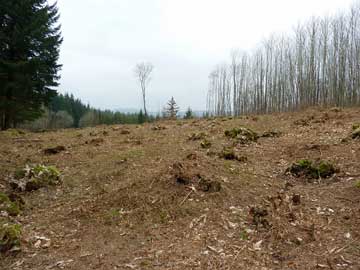
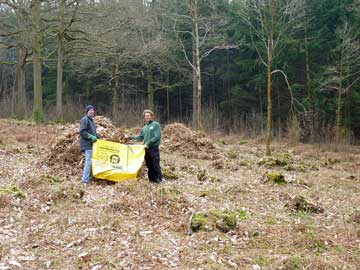
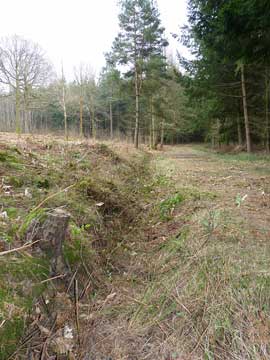
Colin Knight, Paul Day and I joined National Park ranger Graham West and a dozen volunteers to improve habitat for the Pearl-bordered Fritillary (PBF) at a small site north of Midhurst on Tuesday. Amongst the South Downs volunteers was co-Species Champion for the Silver-studded Blue, Arthur Greenwood, who floats between the BC Surrey, Hants and Sussex Branches, and who used to monitor this site back in the 1980s, when the PBF was a much more widespread and numerous species. Our team focused on a strip of sweet chestnut that I had helped coppice last week, which has stubbornly refused to produce much violet since being cleared four years ago. The bracken and leaf litter here had built up to form an excessively deep blanket, so the arduous process of raking a large area began (no recent breeding here). It soon became obvious that the mounds of cleared material were becoming too large to ideally be left on the slope, so I headed for the local builder's supplier to pick up a Hippo Bag (other brands of large, vinyl, folding, builder's refuse sack are available). This proved ideal for the task (modelled by Paul and Arthur) and before too long the slope was clear. Hopefully, this clearance and disturbance of the ground will encourage violet to become better established, but some consistently violet-free areas are being seeded and plugged. We also spent some time clearing a ditch and bank structure at the base of the slope, as these features are favoured egg-laying sites for PBF. Thanks to all who attended, and particularly Colin and Paul, who have answered every call for help with the Fritillaries for the Future project sussex-butterflies.org.uk/FritillariesForTheFuture in recent weeks. (Neil Hulme)
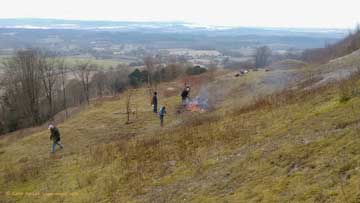
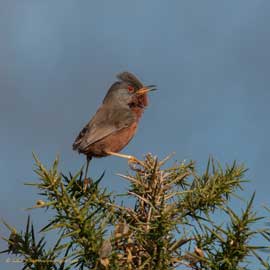
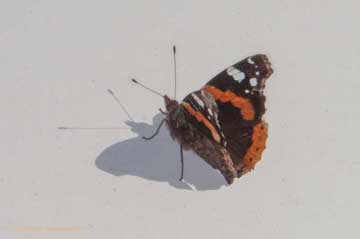
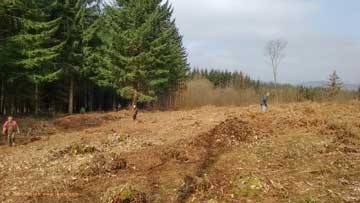
I joined Neil Hulme and Paul Day at a work party at a West Sussex PBF site on Tuesday. The morning started well when a Red Admiral landed on a white vehicle in the car park. We raked a ton of leaves and dead bracken to reveal good substrate for the violets which were already growing in some areas. Yesterday I joined Garry Philpott and Nigel Symington at our Heyshott party where we joined Murrary Downland Trust volunteers to clear more hillside for the Dukes. Afterwards I visited a common and found Dartford Warblers and later a Marsh Tit in Rewell Wood. (Colin Knight www.seapic.com)
Tuesday 15 March
My father, Roy Symonds reports the following sightings on 15th March at Stansted Forest (SU7411) where the temperature was 11.5°C. Brimstone (4 Males) and Comma (2). Three of the Brimstones were in flight while another was disturbed from the ground. One Comma was seen in flight while another landed on Ivy growing against an Oak tree. (Richard Symonds)
News for Sunday 13 March:
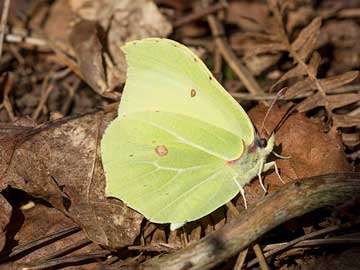
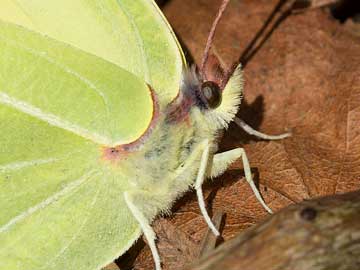
It was nice to everyone and the Brimstones at Rowland Wood last Sunday. And a good way to end the work parties for the winter. (Gary Norman)
Monday 14 March
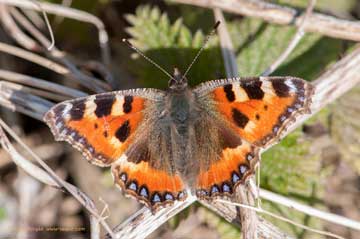
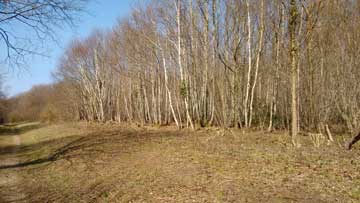
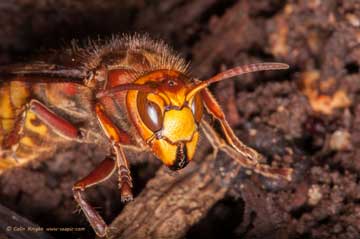
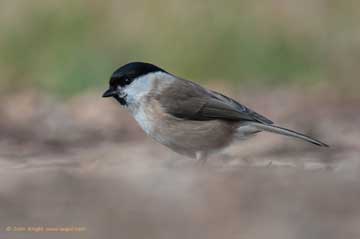
Following a tip from Neil about Small Tortoiseshells at Ferring Rife on Sunday, I visited on Monday and saw six, including two fighting. Things are warming up! On Friday following Neil's work party at Rewell Wood I saw a pair of Marsh Tits, also a hibernating queen hornet under bark in another wood. Firecrests and Goldcrests have also been busy locally,(Colin Knight www.seapic.com )
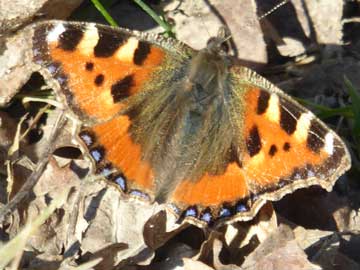
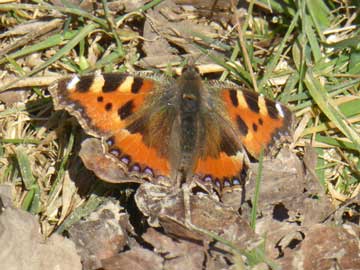
A lovely walk today in sunshine, in St Leonards Forest. I saw a Small Tortoiseshell patrolling a hedgerow in the warmth out of the wind. (Patrick Moore)
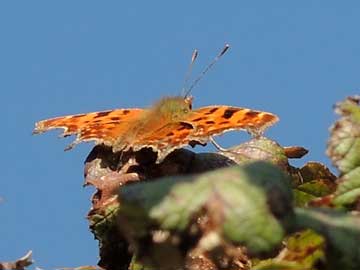
I saw 3 Commas today, one while working in my garden and two while I was checking out Wild Bank Bevendean where 60 sheep will becoming to graze tomorrow. (Geoff Stevens)
News for Sunday 13 March:
My Father, Roy Symonds made a return trip to Stansted Forest (SU741107) today where he saw a Comma in flight which then settled for a photo. The weather was sunny with a temperature of 11°C. In the same woods the day before he saw a Peacock. No signs of any Brimstones yet. (Richard Symonds)
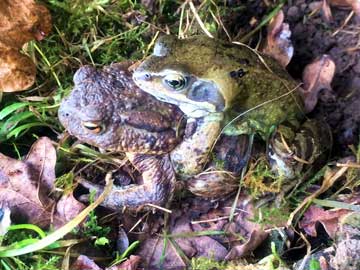
A clear case of mistaken Identity at Knepp today. (Richard Roebuck)
Sunday 13 March
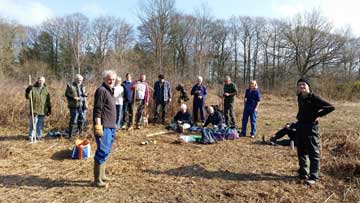
It was the last Park Corner Heath / Rowland Wood work party of the year and I had arranged some sunshine and warm weather especially for the event. As is typical for the last work party of the season the team roamed the reserve undertaking odd jobs here and there; raking, scything, cutting, unblocking, damming, hammering and a few general repairs and tidy ups. Grass Snakes were out and about and the Bog Beacon was emerging - we also found some Harvest Mouse nests too. The highlight of the day was the emergence of the first Brimstones of the year - for most of us our first butterfly sighting of 2016. After the first sighting at around 11:30 we saw several more males patrolling the rides and woodland edges; marking the end of the winter work season and the start of the butterfly season to come. Thank you to everyone who came along today; Alan, Helen, Denise, Carola, Nigel, Malcolm, Keityh, Ian, Julie, Gary, Mike, John, Jonathan, Max, Mark and Theresa. And thanks to everyone else who has joined us over the winter. (Michael Blencowe)
A good haul of butterflies today, while diligently helping my daughter with her school assignment (Looking for Signs of Spring). At Houghton Forest we saw 2 Brimstone, 2 Small Tortoiseshell and a Peacock. At Ferring Rife we counted 12 Small Tortoiseshell. She should get an A* for that lot. The previous day I saw 2 Brimstone while driving through Findon Valley. It looks like it's going to really kick-off this week - goodbye winter! (Neil Hulme)
Saturday 12 March
My father, Roy Symonds today reported to me his first butterfly sighting of 2016. Walking in sunshine during the early afternoon in Stansted Forest, Rowlands Castle (SU742108) he saw a single Peacock flying. (Richard Symonds)
A glorious soft day on my allotment on Whitehawk Hill in east Brighton which seemed to the butterflies liking as I planted my early potatoes. I saw a Comma, a Peacock and a Humming-bird Hawk-moth. The latter rested on a stone for a short while which made me realise that I don't think I have seen one stay still before. Quite a different impression that when they are whizzing from flower to flower. (Tessa Pawsey)
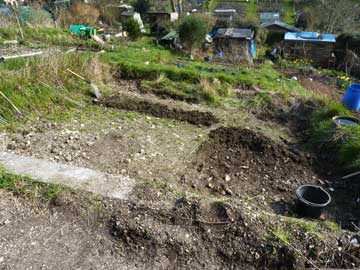
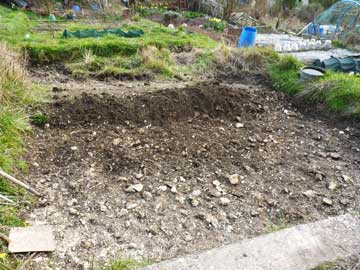
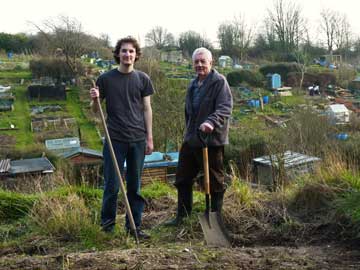
Today at Roedale Valley Allotments the work parties continued on our 'Butterfly Plot'. Thank you to Peter Atkinson for coming to help with the work, much appreciated. Together we removed more soil and began to expose the chalk bed. It was great to meet another Sussex Butterfly Conservation member who has a plot on the other side of the Allotment site, hearing of our work party via dotmailer. After Peter left I continued to expose the chalk bed. The work wasn't completed today but I will be working during the week making it ready for the plants. The next session is going ahead as planned. The plot will just need a once over with a mattock before we can get started. Hope to see you on the 19th March at 11a.m., see the poster for full details near the top of the page. (Jamie Burston)
Recent News:
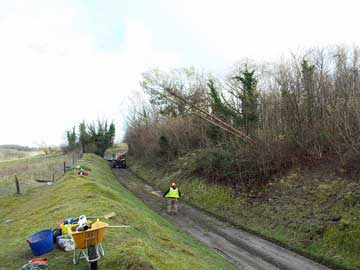
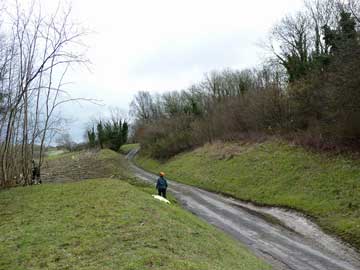
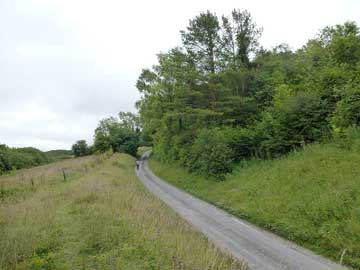
I would like to thank Pauline Chandler and Peter Hogan of West Sussex County Council, and Simon Mockford of the South Downs National Park Authority, for their parts in the successful execution of a technically challenging project at Kithurst (Springhead) Hill recently. WSCC, SDNPA and BC Sussex collaborated to remove some tall pine and ash which have been throwing shade over precious chalk grassland at this important site. As can be seen from the second image in the sequence, a road closure was necessary while the canopy was lowered. Follow-up work parties have cleared encroaching ash and dogwood from other parts of the site. I have no doubt that species including Small and Chalk Hill Blues, Grizzled and Dingy Skippers, and the Duke of Burgundy will all benefit greatly from this work. (Neil Hulme)
Friday 11 March
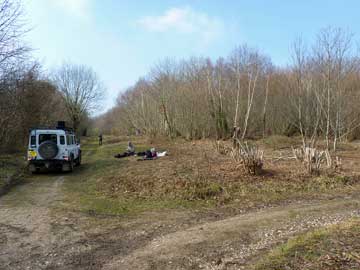
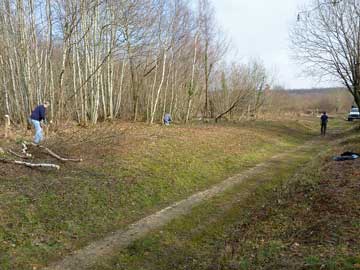
Many thanks to all who turned out for the Fritillaries for the Future work party at Rewell Wood, including the South Downs Volunteer Rangers led by Simon Mockford (National Park). Representing BC Sussex were Colin, Garry, Paul and Steve. It was great to welcome some new blood into the team in the form of Terry, who put his 81 years of experience into shifting as much wood as anyone else. Scallops were cut and rides were widened for the benefit of the Pearl-bordered Fritillary. The habitat here is looking better than ever, and we might be only 6 weeks away from seeing the first Pearl of the year. (Neil Hulme)
Announcement and apology...
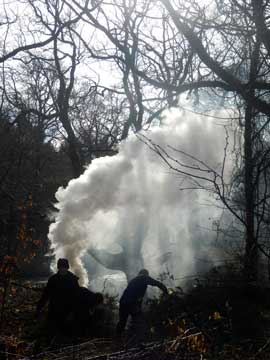
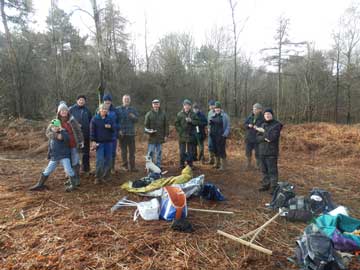
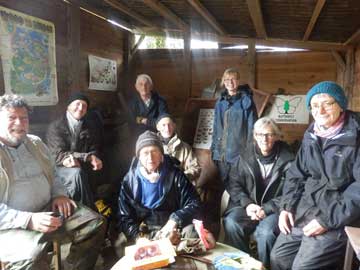
I'll have to start with an apology: I forgot to post a thank you to everyone who attended the Park Corner Heath work party in February. The team worked hard in the small gully and then we tackled the gorse by the shed which has in recent years become too 'leggy'.
We had more help on the reserve this week from the Brighton Conservation Volunteers. Sadly the weather wasn't great but undaunted the team worked hard and helped us to finish off some tasks. Thanks to Mike and his team. We will be back on the reserves this coming Sunday for the last work party of the season. Despite it feeling like winter has only just started spring is indeed almost upon us. We'll be on the reserve from 8:30 until around 12:30 pm but come along and join us when you want. Please bring work gloves and, if you have one, a rake. For more details email Michael sussexgrayling@aol.com (Michael Blencowe)
52 Elm Trees Planted At Dorothy Stringer School
Dorothy Stringer School has a long history of leading habitat creation within the city of Brighton & Hove for local wildlife. The school grounds were the first site on which was constructed a chalk butterfly haven, where 29 species of butterfly have been recorded (76% of the cities butterfly fauna). This is a process that has now been replicated many times throughout the city of Brighton & Hove to create a green network of wild spaces, giving the public direct access to nature on their doorstep.

As a consequence of the construction of Dorothy Stringer School's new floodlit, third generation (3G) artificial grass pitich (AGP) the school has seen the planning mitigation for the site as a great opportunity to enhance further the landscape aesthetic of the Surrenden Campus. Working with Varndean College, Varndean School and Balfour School the school has constructed more butterfly havens on the site and has teamed up with Stanmer Nurseries and Kew's Millennium Seed Bank to sow and plant many thousands of locally sourced wildflowers. As well as planting locally sourced shrubs from "Special Branch" from Stanmer Organics.

In addition to this ongoing effort to increase biodiversity on the site, the school is working with the Sussex Branch of the national charity, Butterfly Conservation, to plant 52 semi-mature disease resistant Elm trees, to provide more arboreal habitat for the nationally rare White-letter Hairstreak butterfly.
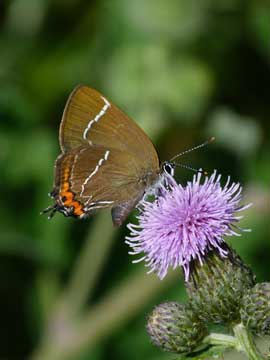
The trees, along with more wildflowers, were planted on Thursday 25th February by The Environmental Science and PE Department, pupils from Dorothy Stringer School and Staff from the Brighton & Hove Parks Department.


The trees have been planted extensively over the Surrenden Campus but the majority are placed close to the Loder road entrance of the school, producing a majestic line of grand parkland trees for future generations to enjoy.
The school's Biodiversity co-ordinator Dr Dan Danahar said: "Butterflies react very quickly to changes in the environment. We know from experience that if we provide the correct habitat the butterflies will come to us. We can't take all of our pupils to the countryside, so we have brought the countryside to them. We have great faith that what we are doing will make a significant contribution to local wildlife conservation."
Grant Lawrence head of the school's PE department said "We are all immensely excited about the provision of such a spectacular new football pitch but we are also delighted that hand in hand with this development, we can see a real improvement in our local natural environment too.
Nigel Symington, Chair of the Sussex branch of the national charity Butterfly Conservation said: "We have been greatly encouraged by the work of Dorothy Stringer School, which is why we had no hesitation in agreeing to fund the cost of the Elm trees that will be planted on the campus. Colonies of the White-letter Hairstreak butterfly at Hollingbury Park, Brighton, attract enthusiasts from all over the UK, who come to see this rare insect. We hope that by planting over 50 more Elm trees so close to the existing colony there will be every possibility that the colony will significantly increase."
News for Sunday 6 March
I know it's not the first Peacock of the year in Sussex, but it was my first butterfly of the year, so very memorable! I saw a Peacock on the Steyning allotments on Sunday. (Debbie Chalmers)
Tuesday 8 March
I've just seen my first Brimstone [of the year] at Woolbeding Common Bowl 1200 hrs (Daryl Watkins)
Monday 7 March
Another bright day with a cold wind whipping up sand in the Wish Park, Hove children's play area sand pit. As we were going home to thaw out, a Peacock in good condition flew past us. It stopped briefly on some purple crocuses. (John & Val Heys)
Saturday 5 March
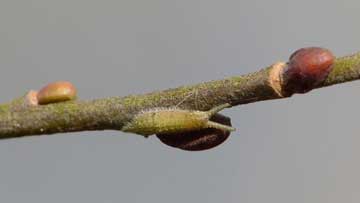
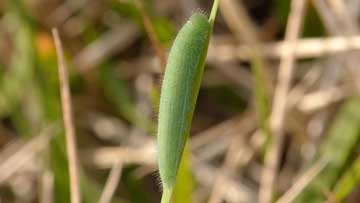
I'm very grateful to Penny Green and Bob Eade for showing me the overwintering stages of the Purple Emperor and Wall Brown this last week. What was really interesting was that the Purple Emperor was clearly hibernating, as you can see from the photo, it has a silken girdle around it waist keeping it in situ (thanks for pointing this out Penny). In contrast the Wall Brown caterpillar was almost imperceptibly moving to get to favourable positions and there was evidence of its previous, recent, feeding (thanks for pointing this out Bob). This slow motion movement was not visible to my eyes but close up video showed it beautifully. Both are remarkable species and both are a delight to see at this early point in the season. (Dan Danahar)
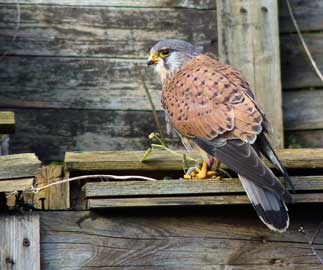
I'd just spent a couple of hrs tidying the garden when through the kitchen window I spotted a beautiful Kestrel sat on one of my raised beds. This just happens to have been occupied by Voles this winter. It was busy eating a small mammal I think, the fur was light grey. Any way I took a few shots through the kitchen window and then through a square of trellis in another closer bed. Luckily it did stop to look up at one point and having eaten its meal flew off. There was a vertical trellis here a week before where at night I had seen a Tawny owl perched. But a few days later a storm brought it down across the bed. Having removed it this morning, perhaps this gave the Kestrel free access for lunch. But a first for me in my garden. Interestingly I have also had Sparrowhawks and a Buzzard in the garden and a Red Kite flying over low down as well. Slightly higher Peregrines and just outside the garden in the summer a Hobby flying past. Nearly a garden tick. (Richard Roebuck)
Friday 4 March
We saw a Small Tortoiseshell which briefly touched down in the children's sand pit at Dyke Road Park, on the Hove side of Dyke Road. Although the sun was shining and the sky blue, the wind was bitterly cold. (John & Val Heys)
Thursday 3 March
With Dan coming over to film Wall Brown larvae at the weekend (weather permitting)!! I had another look today to make sure there are some for him. It was a gorgeous day at High and Over with the sun beating down and the wind being on the other side of the hill. My first confirmed Peacock of the year was flying and basking in the sun. It was then the start of the larvae hunt with 7 Wall Brown larvae seen. I then found my first Speckled Wood larva which was just over 1 cm long. More on the blog: Bobs Butterfly Blog. (Bob Eade)









































































